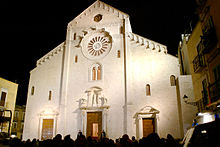Cathedral of Bari
| Bari Cathedral Cattedrale di San Sabino |
|
|---|---|

Façade of Bari Cathedral
|
|
| Basic information | |
| Location | Bari, Italy |
| Geographic coordinates | 41°07′43″N 16°52′06″E / 41.12851°N 16.86838°ECoordinates: 41°07′43″N 16°52′06″E / 41.12851°N 16.86838°E |
| Affiliation | Roman Catholic |
| Rite | Roman |
| District | Archdiocese of Bari-Bitonto |
| Country | Italy |
| Year consecrated | 1292 |
| Ecclesiastical or organizational status | Cathedral |
| Architectural description | |
| Architectural type | Church |
| Architectural style | Romanesque |
| Completed | 1292 |
Bari Cathedral (Italian: Duomo di Bari or Cattedrale di San Sabino) is the cathedral of Bari, in Apulia, southern Italy, senior to, though less famous than, the Basilica of St Nicholas (Basilica di San Nicola) in the same city. The cathedral is the seat of the Archbishop of Bari-Bitonto, as it was previously of the archbishops, earlier bishops, of Bari. It is dedicated to Saint Sabinus, a bishop of Canosa, whose relics were brought here in the 9th century.
The present building was constructed between the late 12th and late 13th centuries, mostly in the last thirty years of the 12th century, and was built on the site of the ruins of the Imperial Byzantine cathedral destroyed in 1156 by William I of Sicily known as the Wicked (il Malo); to the right of the transept it is still possible to observe traces of the original pavement which extends under the nave.
The documented presence of a bishop in Bari goes back to Gervasius, who attended the Council of Sardica in 347, and his successor Concordius, who was present at the Synod of Rome of 465, although names of their predecessors are preserved by tradition, beginning with Saint Maurus in the 1st century. The bishop was elevated to an archbishop in the 6th century, and the presence of a cathedral in Bari is ascertainable from the same period. Under the present nave are traces of an ancient apsed church building from the period before the first millennium, which had three aisles and square pilasters, and foundations on an axis slightly out of alignment with that of the present cathedral. One of the mosaic pavements bears an inscription with the name of Bishop Andrea (758 - 761) and it seems highly likely that these are the remains of the first cathedral, which was destroyed in the 9th or 10th century.
In the first half of the 11th century the then archbishop (1025–1035) ordered the construction of a new episcopal church, which was finished under his successors Nicola I (1035–1061) and Andrea II (1061–1068). This church was then destroyed by William the Wicked (William I of Sicily) along with the rest of the city (only the Basilica of St. Nicholas was spared), which took place in 1156. At the end of the 12th century Archbishop Rainaldo began the reconstruction of the cathedral, reusing materials from the preceding church and other destroyed buildings. Consecrated on 4 October 1292, the new cathedral was built in the style of the Basilica of St. Nicholas, which had served as the episcopal seat in the interim.
...
Wikipedia
